plants
1/68
Earn XP
Description and Tags
Name | Mastery | Learn | Test | Matching | Spaced |
|---|
No study sessions yet.
69 Terms
vascular plants
plants that have xylem and phloem (ex. cacti)
bryophytes/non vascular plants
plants that do not have xylem and phloem (ex. moss)
cotyledon
significant part of the embryo found within the seed
protoplast
inside the plant cell
apoplast
plant cell wall
equation of photosynthesis
6CO2 + 6H2O → C6H12O6 + 6O2
carbon dioxide + water → glucose+ oxygen
tropic responses
plants control the direction of growth of their root and shoots
tropism: process of growth based off a stimulus
positive tropism: growth towards the stimulus
negative tropism: growth away from the stimulus
they respond to stimuli like gravity or sunlight
phototropism
growth in response to light
what plants tend to do
the side of the shoot facing the brighter light is stimulated to grow at a slower rate than the shadier side so the shoot curves towards the direction of maximum light intensity
it increases the amount of light absorbed by a shoot’s leave for photosynthesis
particularly useful in places such as forests where there is competition for light and the light source may not be directly above
Gravitropism
growth in response to gravitational force (down),
how most roots grow
phytohormones
plant hormones that act as signalling chemicals , respond to stimuli and control plant growth and development.
inhibit or promote growth by affecting rates of cell division and cell enlargement
inhibit or promote development of aspects such as shoot, leaves, flowers and ripening
control tropic responses
Ethylene
fruit ripening and development
positive feedback: ethylene→ ripening → ripening fruits produce ethylene
it is released as a vapour and can diffuse to other fruits to initiate their ripening to synchronize the ripening of all the fruits on a plant. ensures to animals that plenty of ripe fruit will be available at the time, and is useful for farmers.
fruit ripening
colour changes, fruit flesh softening, scent changes, acids and starch converted to sugar. this happens so that the scent attracts animals, which disperse seeds.
colour changes from green
cell walls are partly digested to soften the flesh
acids and starch convert to sugar to make the fruit palatable
volatile substances are synthesized to give off a scent
Cytokinins
control cell division
if nutrient and water is available, cytokinin is produced in roots and transported to the shoot to stimulate growth
produced in the root tips and transported up into shoots
synergism
sometimes auxins and cytokinins work together to stimulate a process (stimulating cell division and enlargement of tips, stems and roots)
antagonism
when cytokinins and auxins have opposing effects (development of branches of roots or new roots, only auxin, or development of lateral buds into branches of the stem, only cytokinin)
jasmonic acid
responds to external stimuli, triggers secretion of enzymes in venus fly trap
gibberellin
affects rate of cell division and stem growth, stimulates stem elongation
gibberellic acid (GA): plant growth hormone required for seeds development. it converts the protein reserves in the cotyledons of the seed to hydrolytic enzymes (proteins that break down bacteria, also found in the gut). it also stimulates mitosis and cell division, as well as the synthesis of the enzyme amylase
amylase
breaks down stored starch → hydrolysis (process of using water to break down a molecule into two parts)→ maltose → hydrolysis → glucose → used for respiration and is absorbed by radicle and plumule
auxin (IAA)
the main growth hormone in plants, causes phototropism response. CH2COOH
how auxin is transported
when the sunlight is overhead, the auxin molecules produced by the apical meristem (region of cells capable of division and growth in the root and shoot tips in plants) are distributed throughout the shoot
auxin enters cells by passive diffusion
cytoplasm of plant cells is slightly alkaline, so when auxin enters a cell, the carboxyl group loses a proton (COOH → COO-)
negative charge means it is trapped inside the plant cells
auxin efflux carriers: membrane proteins produced by plants cells that pump auxin into the cell wall
auxin enters acidic cell wall → COO- → COOH→ diffuses into adjacent cell
effect of auxin
once the sunlight shines on the root at an angle, the auxin molecules move to that side, stimulating the elongation of cells on that side, resulting in the bending of the shoot towards the light
this happens because plant cells control the distribution of auxin efflux carriers to move them where they are needed so auxin is pumped out on the side away from the light
auxin stimulates growth in shoots but inhibits growth in roots
high concentration of auxin promotes growth and faster cell enlargement
Auxin directly affects components of growing cells, including cell walls, and gene expression mechanisms operating in the nucleus.
auxin also promotes the synthesis of proton pumps in the plasma membrane which transport H+ ions from the inside of the cell to the cell wall.
cell walls during growth
constructed using microfibrils (bundles of cellulose molecules). When the wall needs to be thickened, extra microfibrils are made and pushed through the plasma membranes. They are not elastic and cannot grow, they can only slide further apart or closer together. they are connected by crosslinks made of carbohydrates, including pectin. the lower the pH in the crosslinks, the weaker the link (pH lowers when the wall must extend).
auxin promotes hydrogen secretion into cell walls and space between cells, acidifying the wall. low pH → protein called expanisin→ alter pattern of hydrogen bonding of polysaccharide in the cell wall → loosen crosslinks
turgor pressure
contributes to cell growth
An increase in the turgor pressure leads to the expansion of cells and helps resist gravity and wind, happens via osmosis when the stomata are open. the cell wall allows high turgor pressure to build inside the cells without it bursting.
apical dominance
a lot of auxin is produced by shoot apical meristem (shoot tips,cells that generate above-ground aerial organs throughout the lifespan of higher plants) and it promotes growth in shoot apex (the bud, the tip of the stem, which contains meristematic cells and the region of growth. It develops into lateral branches, leaves, flowers) and inhibits lateral buds (buds that may be specialized into forming shoots)
Eventually the distance between terminal bud and lateral buds gets larger and auxins are less effective
auxin efflux pumps
set up concentration gradients within tissues. plant cells produce these pumps within their membranes
auxin enters alkaline cytoplasm via passive diffusion through auxin influx carriers→ loses a proton→ COO- with a negative charge → trapped inside the plant cell→ charged auxin is pumped into cell wall via auxin efflux pumps→ cell wall is acidic, so auxin reverts to uncharged state and diffuses into adjacent cell.
flower
part of the plant used for sexual reproduction (although plants without flowers can reproduce sexually). where meiosis, gamete production and fertilisation happen
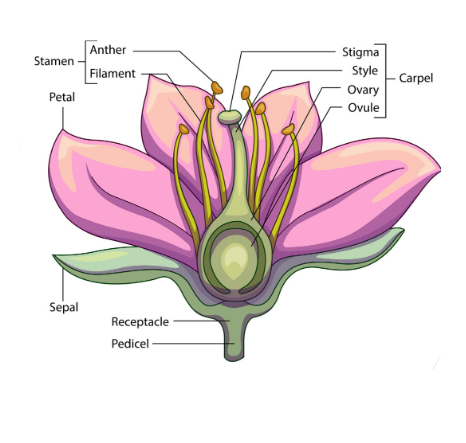
stamen
male parts of the flower
anther: contains pollen grain
pollen grains: in the anther diploid cell → meiosis → 4 haploid cells → each develops into a pollen grain → nucleus divides again via mitosis to become 3 haploid nuclei (2 become male gametes, 1 use during pollen development and fertilisation)
filament: stalk that supports the anther
carpel
female parts of the flower
stigma: receives pollen
style: connects sigma to ovaries
ovary: contains 1 or more ovules. one or several ovules are attaches to the ovary walls by a stalk
one cell in the ovule→ grows large → divides by meiosis→ four haploid nuclei → one divides three times (mitosis)→ eight haploid nuclei, one of which is the female gamete, the others assist in fertilisation and embryo development
sexual reproduction in flowering plants
pollination: pollen transferred from one stigma to another by wind or insects. since plants are hermaphrodite, they have the ability to self-pollination
fertilisation: a tube carrying male gametes from pollen grows down the style to an ovule in the ovary → pollen is inside ovary → pollen tube grows towards one ovule→ pollen tube reaches centre of ovule where the female gamete is locate → male gametes are released → fertilisation occurs→ produces a zygote
seed dispersal: zygote→ develops into an embryo with an embryo root, shoot and one or two leaves (cotyledons)→ seed → dispersed by wind or animals
Cross-pollination
transfer of pollen from an anther in a flower to a stigma of another plant.
promotes genetic variation, diversity and evolution
ways that plants promote cross pollinate: anthers and stigmas are sometimes on very separate parts of the plant and anthers and stigmas mature at different times
protandry: anthers (male parts) develop first
protogyny: stigmas (female parts) develop first
Self-pollination
pollen from the same plant is transferred to the stigma of that plant
most plants have different alleles (gene variations) to prevent self-pollination
anatomy of a seed:
radicle: root
plumule: shoot
testa: seed coat
micropyle: tiny spot where water enters
cotyledons: story energy (proteins) for germination
epicotyl: embryonic stem
seed is surrounded by fruit flesh to nourish and protect embryo
ovule develops into the seed and the ovary develops into the fruit
seeds need to travel to reduces competition for resources between offspring and parent
dispersal: animals, wind, self dispersal (sort of a little explosion)
germination
the sprouting of a seed/spore after a period of dormancy breaks (usually begins after the seed coat is removed so that water can enter)
some seeds do not immediately germinate even if the conditions are right due to a period of dormancy, which allows for seed dispersal
seeds require water, oxygen, proper temperature and sometimes light to germinate
water is absorbed by the embryo → GA synthesizes→ rehydration→ cell expansion→ rate of respiration increases → metabolic processes resume/begin → structural changes in organelles
stages of germination
the radicle (young root) emerges first and anchors the seedlings in the soil and absorbs water and mineral ions. the water washes out the germination inhibitors that were keeping the seed dormant
testa is split and the young embryo stem emerges
stem grows upwards in a hooked shape to protect young leaves
foliage leaves begin to show ,the plumule emerges above ground and straightens
insect pollinated plants
Feature | Insect Pollinated |
|---|---|
Colour/shape of petals | Large and brightly colored to attract insects |
Scent and nectar present? | Usually scented and with nectar, serves as food for insects |
Number of pollen grains | Moderate |
Mass, weight, structure of pollen grain | Sticky or spikey, attaches easily to insects body |
Location of anthers | Inside the flower, stiff and firmly attached – to brush against insects |
Location of stigma | Inside the flower, sticky, pollen adheres to it when insect brushes. |
wind pollinated plants
Feature | Wind Pollinated |
|---|---|
Colour/shape of petals | Small, often dull green or brown in color |
Scent and nectar present? | No scent of nectar |
Number of pollen grains | Large number, since wind pollination is more random |
Mass, weight, structure of pollen grain | Smooth and light, are easily carried by the wind without clumping |
Location of anthers | Outside the flower, loose on long filaments to release pollen easily. |
Location of stigma | Outside the flower, feathery – form a network to catch drifting pollen. |
nitrogen
helps with chlorophyll production. plants can’t directly absorb nitrogen from the atmosphere, and instead bacteria convert it into nitrate in the soil, from where plants absorb it
starch
when glucose isn’t absorbed, it’s stored as starch
waxy cuticle
thick, waterproof layer on upper surface, has lower permeability to gases. wax is secreted by epidermal cells. particularly thick on plants adapted to dry habitats
epidermis
outer layer of cells in all parts of a young plant. lower epidermis contains stomata and has guard cells that open stomata. helps protect the leaf by aiding in preventing water loss and providing an extra layer between the outside and inside of the leaf.
dicots typically have transport tissue in vascular bundles near the epidermis
palisade mesophyll
cells that contain a lot of chloroplasts
chloroplasts: organelles that perform photosynthesis. they require a supply of CO2 to photosynthesize and the oxygen produced as a waste product must be removed.
spongy mesophyll
provide a moist and large total surface area for gas absorption. photosynthesis raises oxygen concentration in chloroplasts, which then diffuses to the surface of spongy mesophyll cells and out of the leaf. some of the moisture will evaporate unless it is humid.
stomata
pore that allow oxygen, water and CO2 to move in and out. they are controlled by guard cells
plants in hot, dry conditions tend to open their stomata at nighttime to preserve water
Two guard cells surround each stoma, and changes in turgor pressure of the guard cells regulate the size of the stoma. An increase in guard cell turgor results in stomatal opening, whereas a reduction in turgor leads to stomatal closure
veins
where sugars and water are transported (xylem and phloem)
xylem: transports water/nutrients from roots to stem/leaves upwards
phloem: transports water/nutrient from leaves to other parts of the plant and to roots, upwards or downwards. source → sink
transpiration
process where water leaves the xylem vessels through evaporation
potometers
potometers measure the rate of water uptake of a leafy shoot since photosynthesis and transpiration cause water uptake
they measure the amount of water lost/m²/min
it consists of a plant cutting, a calibrated pipette to measure water loss, a length of clear plastic tubing that water flows through and an air tight seal between the plant and the tubing, usually sealed with petroleum jelly
testing different variables with a potometer
temperature, by increasing the temperature in the room with heaters (should increase rate of transpiration)
humidity , by encasing the plant in a plastic bag with a certain level of vapour (should decrease rate of transpiration)
light intensity, by changing the distance of a lamp (should increase rate of transpiration, causes more stomata to open because plants open their stomata in response to light, allowing water vapour to escape from the leaves)
wind exposure, fans will remove water vapour from near the leaf, reducing proximal humidity. (should increase rate of transpiration)
surface area, can be altered by putting nail polish/petroleum jelly on stomata (should decrease rate of transpiration)
transpiration rate and its correlation with different factors
positive correlation with temperature: more energy for evaporation and warmer air can hold a lot of water vapour
negative correlation with humidity: the higher the humidity, the smaller the concentration gradient of water vapour between the air spaces in the leaf and the air and so the lower the rate of diffusion
positive correlation with wind speed because the force of the wind can remove water vapour from near the leaf, reducing proximal humidity
determining stomatal density
stomatal density (mm⁻²)=means number of stomata/ area of field of view (mm²)
vascular bundle
xylem and phloem together, with cambium in the middle
xylem sap
water with low concentrations of ions such as potassium and chloride that fills xylem vessels
structure of xylem
long continuous tube of dead cells
have larger tubes than phloem
hollow
allows free movement of water in one direction, upwards because main flow of water is from roots to leaves.
flow of water is passive since xylem vessels are not living
cell wall pits allows water to be transferred between cells
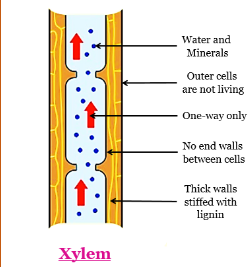
adhesion
cell walls contain a mesh of hydrophilic cellulose molecules
adhesion: water is attracted to the hydrophilic part of the cell walls of xylem, so a loss of water causes more water to be drawn out of cell walls by xylem vessels in nearby veins. this pulling generates tension→ cohesion
all the energy required for adhesion/cohesion comes from the heat that causes transpiration
cohesion
attraction between water molecules. water is a polar molecule → negative dipole is attracted to hydrogen in neighbouring water molecules → cohesion
all the energy required for adhesion/cohesion comes from the heat that causes transpiration
monocotyledon
one group that flowering plants are divided into, ex. lilies, garlic. xylem vessels are large open tubes arranged in a ring. flower parts are in threes/multiples of threes
dicotyledon
one group that flowering plants are divided into, ex. sunflower, trees. xylem vessels are large open tubes arranged in a cross. flower parts are in fours/fives/multiples of fours/fives
root pressure
roots take up water (osmosis, low solute concentration outside the root and high solute concentration in the root due to the minerals) and minerals (active transport, specific ion pumps) from soil → water increases pressure in the root → water is pushed up the xylem
positive pressure potential, greater energy potential in the system
causes water movement in roots and stems when transpiration is not enough
happens in high humidity or in spring before the leaves have opened
translocation
movement of phloem sap from a source to a sink in a plant
source
exporting region that produces lots of sugar. ex. photosynthetic tissues such as mature green leaves, green stems or storage organs such as germinating seeds, roots and tubes at the start of the grow season
sink
importing region that does not produce sugar and need it delivered. ex. parts that store sugars such as developing tap roots or parts that are doing a lot of cellular respiration to make ATP to develop fruits, seeds or grow leaves.
structure of phloem
sieve tube cells : the major conducting cells in phloem made of cellulose. don’t really have organelles
sieve plates help support the strength of the sieve tubes and has large pores that allow the sap to flow through
companion cells: adjacent to sieve tubes, have organelles to perform genetic & metabolic (ATP) functions to maintain the sieve tube cells
plasmodesmata: a thin cytoplasmic connection between the cytoplasm of companion cells to allow for communication , ATP transport and sucrose transport
sieve tube elements are the remaining subunits of sieve tubes that have a membrane and use ATP to load and unload sucrose via active transport. they have few or no mitochondria of their own and require adjacent companion cells for fuel. not all plants have them
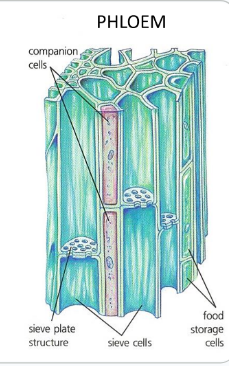
Dicot stem structure
xylem: transports water from roots to leaves
phloem: transports sugar from leaves to roots
epidermis: outer layer of plant cells that provides waterproofing and protection
cambium: produces more cells for xylem and phloem, consists of a layer of stem cells
cortex: supports the stem and photosynthesizes
pith: bulks out the stem and stores nutrients
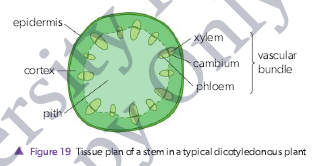
Dicot root structure
in a dicot root, the vascular tissue is all grouped at the centre with xylem in a star shape and phloem between the star’s point.
xylem: transports water from roots the leaves
phloem: transports sugar from leaves to roots
epidermis: outer layer of plant cells that provides waterproofing and protection and absorbs mineral ions and water from the soil often using root hair
cortex: unspecialized cells that bulk out and strengthen root
endodermis: inner layer of cells that water passes through
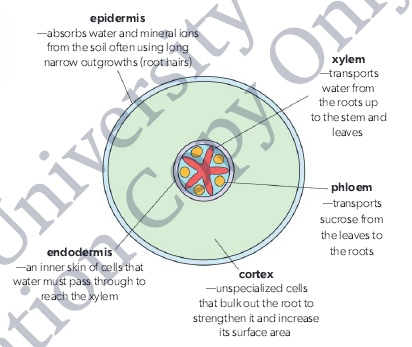
tension of xylem sap and transpiration
if the plant is transpiring, the xylem sap will be under tension, tension strong enough to draw the water out of root cells and into xylem vessels, although xylem sap is hypotonic compared to the root cells.
cohesion allows water to against the rules of osmosis
if the plant is not transpiring (high humidity, nighttime, deciduous trees trees that are leafless in winter and don’t have sap), there is likely to be positive pressure rather than tension in the sap, so another mechanism is required to move water into the xylem vessel.
root pressure
mechanism that refills xylem vessels with sap when they are only filled with air or the sap is not under tension.
root cells near xylem vessels actively transport mineral ions into the xylem using ATP and pump proteins in the plasma membranes of the living cells. tension in the roots is generated by attractions between soil particles and water
xylem sap is now hypertonic
water moves into xylem vessels via osmosis
pressure inside vessels rises
sap is pushed upwards, with no height limit
Hydrostatic pressure
the force within the cell that pushes the plasma membrane against the cell wall.
The cellulose cell walls of sieve tube elements are thick enough to withstand the high pressure, strengthened by the sieve plates bracing it
The plant cell is fully turgid (normal, healthy state) when the hydrostatic pressure is at the maximum
sugar is actively transported into phloem
high solute concentration develops in the sieve tubes of the source (the solute consists of the sucrose and other compounds being transported)
draws water in by osmosis
increases hydrostatic pressure
sap travels to sink
compounds are unloaded by active transport
solute concentration lowers
water exits by osmosis
hydrostatic pressure drops
Plasmolysis
when water is removed from plant cells due to overexposure to a hypertonic solution, causing a decrease in the volume of the cytoplasm, with the plasma membrane pulling away from the cell wall. Usually results in the death of the cell
Mass flow:
Movement of dissolved nutrients into a plant as the plant absorbs water for transpiration
lignin
a polymer that thickens the xylem wall so it won’t be affected by pressure
in xylem vessels, usually young plants, the lignin exists in rings or helices
in tracheids, usually old plants, there are holes called pits